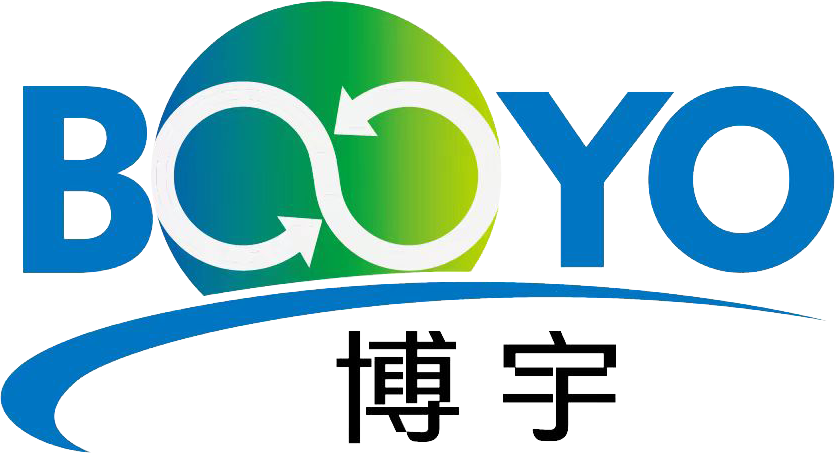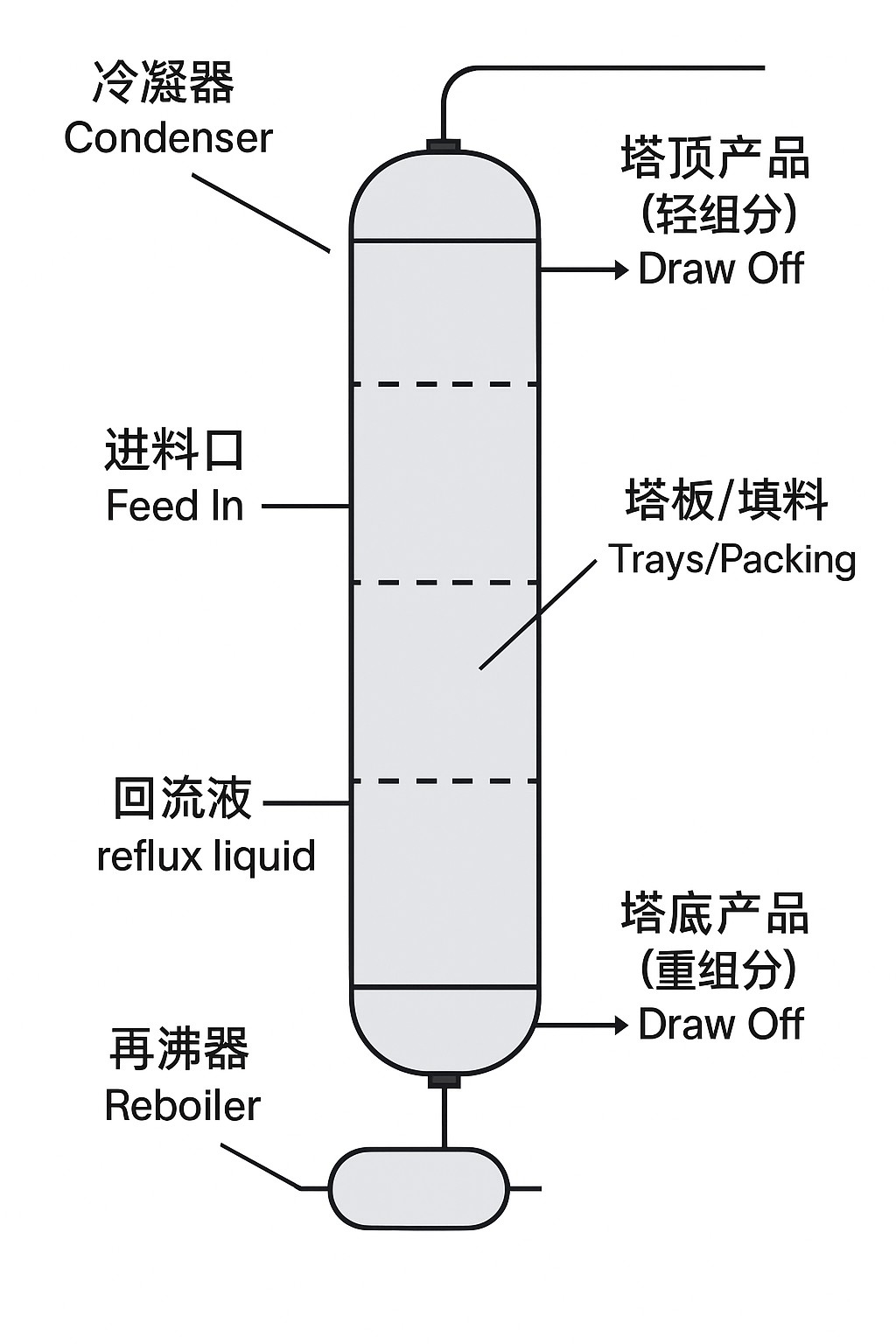
Our News
Find out about our latest news here.
Latest News
- ▶ Shell and Tube Heat Exchanger Cost Estimate: A Complete Guide for Buyers
- ▶ Iraqi Client Visited Boyu Industry for Technical Inspection of Condensers and Process Columns
- ▶ Shell and Tube Heat Exchanger Manufacturers: Key Factors for Choosing the Right Supplier
- ▶ Applications of Shell & Tube Heat Exchangers in MEG Packages (Monoethylene Glycol Systems)
- ▶ High-Efficiency Surface Condenser Solutions:
- ▶ Health, Safety and Environment (HSE) Policy
Message
Fundamental Principles of Distillation
1.1 Vapor-Liquid Equilibrium (VLE)
Distillation relies on the concept of vapor-liquid equilibrium, which describes how components in a liquid mixture distribute themselves between vapor and liquid phases at a given temperature and pressure. The relative volatility (α) of the key components determines the ease of separation:
where and are the mole fractions in the vapor and liquid phases, respectively.
1.2 Theoretical Stages and Actual Stages
Theoretical Stage: One equilibrium stage where the exiting vapor and liquid phases are in equilibrium.
Actual Stage: Real trays or packing sections, accounting for efficiency losses (Murphree tray efficiency, HETP for packing).
The number of stages required can be estimated using the McCabe-Thiele or Ponchon-Savarit methods for binary mixtures, and shortcut methods (e.g., Fenske, Underwood, Gilliland equations) for multicomponent systems.
1.3 Material and Energy Balances
A typical distillation column is analyzed using overall and component material balances, as well as energy balances for heat input (reboiler) and removal (condenser).
Where F is feed, D is distillate, B is bottoms, and are compositions.
2. Column Internals and Configurations
2.1 Tray Columns
Tray Types: Sieve trays, valve trays, bubble-cap trays.
Design Parameters: Tray spacing, active area, weir height, downcomer sizing.
Hydraulics: Weeping, dumping, entrainment, and flooding are key considerations.
Tray Efficiency: Typically 60–80%, depending on design and operating conditions.
2.2 Packed Columns
Packing Types: Random packing (Raschig rings, Pall rings, Berl saddles), structured packing (Mellapak, Flexipac).
Key Parameters: Packing factor, surface area, pressure drop, HETP (Height Equivalent to a Theoretical Plate).
Applications: Vacuum distillation, heat-sensitive or corrosive systems.
2.3 Advanced Configurations
Dividing Wall Columns (DWC): Enable simultaneous separation of ternary mixtures, reducing energy consumption.
Reactive Distillation: Combines chemical reaction and separation in one column.

3. Design and Sizing Considerations
3.1 Feed Conditions
Feed Location: Determines energy efficiency and stage usage.
Thermal Condition (q-line): The ratio of liquid/vapor in the feed affects stage calculations.
3.2 Reflux Ratio
Minimum Reflux Ratio: Theoretical minimum for desired separation (infinite stages).
Operating Reflux Ratio: Practical value (usually 1.2–1.5 times minimum) to optimize capital and operating costs.
3.3 Column Sizing
Diameter: Determined by vapor/liquid traffic to avoid flooding or weeping.
Height: Based on the number of theoretical stages (trays or HETP for packing).
Where A is cross-sectional area, V is vapor flow rate, u is allowable vapor velocity, and ρ is density.
3.4 Pressure and Temperature
Operating Pressure: Affects relative volatility, tray efficiency, and utility costs.
Vacuum Columns: Used for heat-sensitive or high-boiling mixtures.
4. Operation and Control
4.1 Startup and Shutdown Procedures
Careful ramp-up of feed and reboiler duty to avoid thermal shock and hydraulic surges.
4.2 Control Strategies
Level Control: Reboiler and condenser levels.
Pressure Control: Top and bottom pressures.
Temperature Control: Critical for product quality.
Composition Control: Advanced columns use online analyzers and control loops.
4.3 Troubleshooting
Flooding: Excess vapor traffic—lower feed/reflux or increase diameter.
Weeping/Dumping: Low vapor rates—raise reboiler duty or decrease pressure.
Foaming/Entrainment: Adjust feed quality and antifoam injection as needed.
5. Energy Efficiency and Modern Developments
Heat Integration: Use of heat pumps, feed preheaters, and energy recovery systems.
Process Intensification: Use of DWCs, reactive distillation, and hybrid separation methods.
Digitalization: Advanced process control, simulation, and real-time optimization.
6. Industrial Applications
Petroleum Refining: Crude distillation units, FCC gas plants, solvent deasphalting.
Chemical Manufacturing: Ethylene/propylene production, aromatics separation.
Pharmaceuticals & Fine Chemicals: High-purity solvent recovery, enantiomer separation.
Environmental Protection: Solvent recovery from waste, desalination.
7. Conclusion
Distillation columns are the backbone of separation processes in the chemical and process industries. Their design and operation require careful consideration of thermodynamics, fluid mechanics, heat and mass transfer, and process control. With ongoing advances in column internals, process intensification, and automation, distillation remains both a classic and continuously evolving technology.
PROFESSIONAL CONSULTATION
If you are interested in our products and want to know more details, please leave a message here, we will reply you as soon as we can.